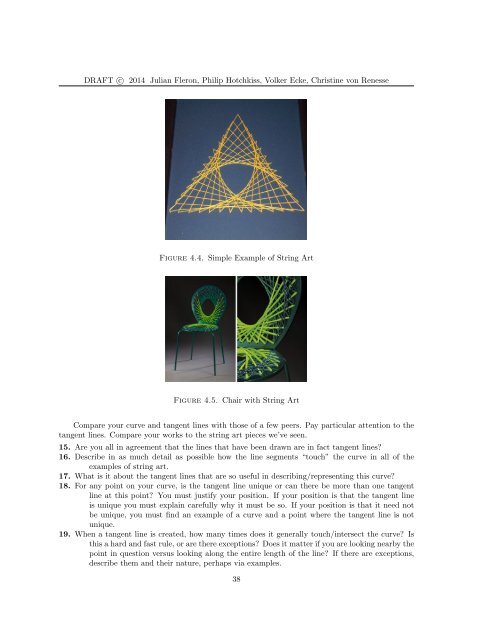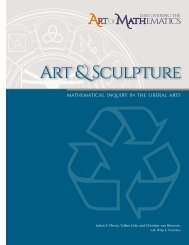calculus-2014-05-21
calculus-2014-05-21
calculus-2014-05-21
Create successful ePaper yourself
Turn your PDF publications into a flip-book with our unique Google optimized e-Paper software.
DRAFT c○ <strong>2014</strong> Julian Fleron, Philip Hotchkiss, Volker Ecke, Christine von Renesse<br />
Figure 4.4. Simple Example of String Art<br />
Figure 4.5. Chair with String Art<br />
Compare your curve and tangent lines with those of a few peers. Pay particular attention to the<br />
tangent lines. Compare your works to the string art pieces we’ve seen.<br />
15. Are you all in agreement that the lines that have been drawn are in fact tangent lines?<br />
16. Describe in as much detail as possible how the line segments “touch” the curve in all of the<br />
examples of string art.<br />
17. What is it about the tangent lines that are so useful in describing/representing this curve?<br />
18. For any point on your curve, is the tangent line unique or can there be more than one tangent<br />
line at this point? You must justify your position. If your position is that the tangent line<br />
is unique you must explain carefully why it must be so. If your position is that it need not<br />
be unique, you must find an example of a curve and a point where the tangent line is not<br />
unique.<br />
19. When a tangent line is created, how many times does it generally touch/intersect the curve? Is<br />
this a hard and fast rule, or are there exceptions? Does it matter if you are looking nearby the<br />
point in question versus looking along the entire length of the line? If there are exceptions,<br />
describe them and their nature, perhaps via examples.<br />
38



